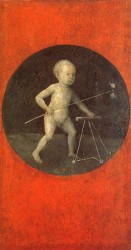
Gibson 1975
“Bosch’s Boy with a Whirligig: Some Iconographical Speculations” (Walter S. Gibson) 1975
[in: Simiolus, vol. 8 (1975-76), nr. 1, pp. 9-15]
[Also mentioned in Gibson 1983: 76 (E20)]
On the reverse of the Christ Carrying the Cross wing (Vienna, Kunsthistorisches Museum) Bosch painted a naked boy pushing a little walking frame in front of him and carrying a whirligig in his right hand. Tolnay (and others before him) interpreted the boy as the Jesus Child and saw the scene as a foreshadowing of Christ’s troublesome Way of the Cross (represented on the front of the panel). Bax, though, interpreted the child as a symbol of the folly of those who don’t understand Christ’s Passion.
In two other scenes Bosch painted a whirligig: on the right inner wing of the Lisbon St. Anthony triptych (where it is attached to the dress of a monster in a walking frame) and on the closed wings of the same triptych (where it is held by one of the children who are watching the Way of the Cross). In the Middle Ages symbols could have different meanings, depending on the context. The whirligig could indeed refer to folly but in at least three other works, dating from Bosch’s times, this toy is associated with the Christ Child. In these three works the whirligig cannot have a negative meaning, unless it refers to the human weakness to which Christ deliberately exposed himself.
Probably the toy has to be linked to real windmills which often functioned as symbols of the Eucharist in the later Middle Ages. Therefore it seems important that the angle under which the child holds the whirligig on the Viennese panel corresponds with the angle under which the cross is being carried by Christ on the other side. That the child on Bosch’s panel is indeed the Christ Child is confirmed by late-medieval devotional representations of the Christ Child with the instruments of the Passion. An inscription accompanying a woodcut teaches us that in the late Middle Ages it was believed that Christ’s suffering began long before His Passion.
According to Gibson the child on the Viennese panel is the Christ Child which, while moving forward, realizes its final destination: the Crucifixion.
[explicit]